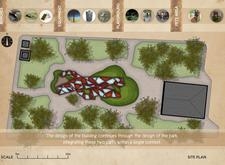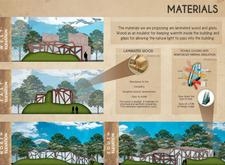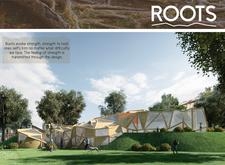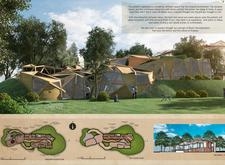5 key facts about this project
The project is characterized by its unique spatial organization, which encourages movement and engagement throughout the site. Key areas include a playground designed for children, a dedicated space for pets, and various community gathering spots. These elements not only serve distinct purposes but also collectively foster a strong sense of community. Each component has been meticulously placed to ensure accessibility and invite users to explore the outdoor and indoor spaces seamlessly.
Materiality plays a crucial role in the project’s success. The use of laminated wood for structural elements contributes both to the natural aesthetic and the durability of the design, providing a warm and inviting feel. This material selection also supports sustainability efforts, as laminated wood is known for its energy-efficient qualities. The incorporation of double glazing with reinforced thermal insulation in the windows ensures that natural light floods the interiors while minimizing heat loss, enhancing the overall energy efficiency of the building. Such materials reflect a dedication to creating an eco-conscious architectural design that aligns with contemporary standards for sustainable living.
The architectural form is both functional and visually engaging, characterized by flowing lines and dynamic shapes that echo the surrounding landscape. The undulating roof design not only adds an interesting visual aspect but also connects the structure to the topography of the site. The interactions between solid elements and transparent surfaces create a dialogue with the environment, blurring the boundaries between indoors and outdoors. This approach to design emphasizes a commitment to creating a nurturing atmosphere that resonates with users, contributing to their physical and mental comfort.
What sets this project apart is its focus on therapeutic design. The arrangement of spaces encourages not only individual reflection and relaxation but also community engagement. This thoughtful consideration of the users’ emotional and psychological needs distinguishes the project, reinforcing the idea that architecture can positively influence everyday life.
Throughout the project, details such as community interaction features, gardens, and thoughtful landscaping underscore the architects' dedication to enhancing the user experience. The landscape design complements the architecture, providing a backdrop that is as engaging as the building itself. By integrating these elements, the project embodies a comprehensive approach to design, allowing users to feel a sense of belonging and connection to both the space and each other.
In summary, this architectural project reflects a deep understanding of the relationship between space, material, and community. It stands as an example of how contemporary architecture can respond to user needs while maintaining a dialogue with the natural environment. For those interested in exploring the project further, a detailed presentation offers insights into the architectural plans, sections, and innovative design ideas that define this notable project. Engaging with these elements will provide a deeper understanding of the thought processes and methodologies that shaped the final design.


























